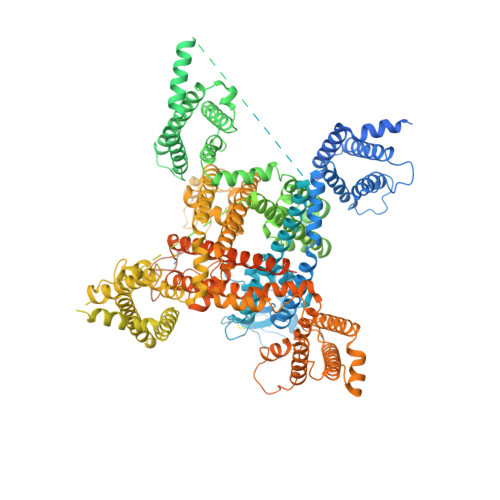Structure of human Na v 1.5 reveals the fast inactivation-related segments as a mutational hotspot for the long QT syndrome.
Li, Z., Jin, X., Wu, T., Zhao, X., Wang, W., Lei, J., Pan, X., Yan, N.(2021) Proc Natl Acad Sci U S A 118
- PubMed: 33712541
- DOI: https://doi.org/10.1073/pnas.2100069118
- Primary Citation of Related Structures:
7DTC - PubMed Abstract:
Na v 1.5 is the primary voltage-gated Na + (Na v ) channel in the heart. Mutations of Na v 1.5 are associated with various cardiac disorders exemplified by the type 3 long QT syndrome (LQT3) and Brugada syndrome (BrS). E1784K is a common mutation that has been found in both LQT3 and BrS patients. Here we present the cryo-EM structure of the human Na v 1.5-E1784K variant at an overall resolution of 3.3 Å. The structure is nearly identical to that of the wild-type human Na v 1.5 bound to quinidine. Structural mapping of 91- and 178-point mutations that are respectively associated with LQT3 and BrS reveals a unique distribution pattern for LQT3 mutations. Whereas the BrS mutations spread evenly on the structure, LQT3 mutations are clustered mainly to the segments in repeats III and IV that are involved in gating, voltage-sensing, and particularly inactivation. A mutational hotspot involving the fast inactivation segments is identified and can be mechanistically interpreted by our "door wedge" model for fast inactivation. The structural analysis presented here, with a focus on the impact of mutations on inactivation and late sodium current, establishes a structure-function relationship for the mechanistic understanding of Na v 1.5 channelopathies.
Organizational Affiliation:
State Key Laboratory of Membrane Biology, Beijing Advanced Innovation Center for Structural Biology, Tsinghua-Peking Joint Center for Life Sciences, School of Life Sciences, Tsinghua University, 100084 Beijing, China.















